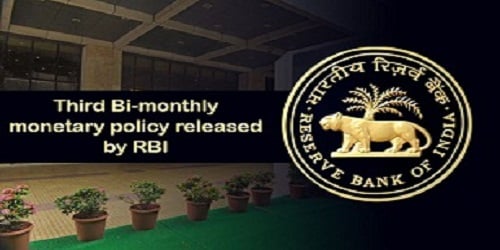On August 7,2019, The Reserve Bank of India (RBI) announced its third Bi-Monthly Monetary Policy Rates for 2019-20 in Mumbai. The three-day (5 to 7 August 2019) policy review meeting by the six members of Monetary Policy Committee (MPC) was headed by RBI Governor Shaktikanta Das with the members – Dr. Ravindra H. Dholakia, Dr. Michael Debabrata Patra, Shri Bibhu Prasad Kanungo, Dr. Chetan Ghate and Dr. Pami Dua. The next meeting of the MPC is scheduled during October 1, 3 and 4, 2019. Highlights of the meet:
Highlights of the meet:
The announcements were made in the meeting include:
- All members of the MPC unanimously voted to reduce the policy repo rate by 35 basis points(bps) under the liquidity adjustment facility (LAF) to 5.40 % from 5.75% for the 4th consecutive time. The move comes in the backdrop of an economic slowdown, low inflation, trade wars, and geopolitical tensions.
- The Reserve Bank of India will create a Central Payment Fraud Registry to monitor digital payments related frauds on a real-time basis and provide customers with periodic aggregated data of risks associated with individual payments operators in a bid to improve customer confidence in these channels.
Current Policy rates under LAF:
| Repo Rate | 5.40 % |
| Reverse Repo Rate | 5.15 % |
| Marginal standing facility (MSF) Rate | 5.65 % |
| Bank Rate | 5.65 % |
Reserve ratios:
| Cash reserve Ratio(CRR) | 4% |
| Statutory Liquidity Ratio(SLR)(will change on October 12, 2019) | 18.75% |
i. MPC also decided to maintain the accommodative stance of monetary policy, which means future rate increase is off the table.
ii. In the earlier three policies, the central bank had reduced repo rate by 25 basis points each.
iii. The benchmark rate is now at the lowest since April 2010.
iv. Statutory Liquidity Ratio(SLR) now reduced by 25 bps to 18.75% from 19%. This will again come down with 18.50 % in October 2019, where the next meet held.
RBI keeps the Retail Inflation Forecast for October-March 2019-20 to 3.5-3.7%
RBI projected the Consumer Price Index(CPI)-based or retail inflation was projected at 3.1 % for the September 2019 quarter and 3.5-3.7 per cent for October-March 2019-20 quarter.
i. April-June 2020 consumer inflation is (CPI) projected at 3.6 percent.
ii. It also projected risks to inflation trajectory from rise in food inflation and lower Kharif output.
GDP growth forecast lowered to 6.9 percent from 7 percent for FY20
The RBI’s MPC cut its Gross Domestic Product (GDP) growth forecast to 6.9 percent from 7 percent for FY20(Fiscal year) due to a slowdown in consumption and Investmnet, which is causing dampening effect on growth.
i.The GDP growth is scaled down from 7% in the June policy to 6.9%- in the range of 5.8-6.6% for the first half of 2019-20 and 7.3-7.5% for the second part-with risks to FY20 GDP growth somewhat tilted on the downside.
ii. RBI also warns that construction sector, the country’s largest jobs provider, activity has weakened in India.
RBI allows round-the-clock fund transfers under NEFT from December,2019
In order to promote digital transactions, the RBI (Reserve Bank of India) has decided to allow the National Electronic Funds Transfer (NEFT) services to be active 24×7 from December 2019 from the current timings of 8.00 am to 7.00 pm on all working days(excluding 2nd and 4th Saturdays of a month). RBI also will set up a registry to track frauds in payment systems.
i. In June policy, the RBI had done away with charges on fund transfers through RTGS and NEFT routes to promote digital transactions.
ii. NEFT(National Electronic Funds Transfer): It is used for fund transfers up to Rs. 2 lakh maintained by the Reserve Bank of India. There is no maximum and minimum limit of money transferred through NEFT.
iii. Real Time Gross Settlement System (RTGS): It is for large-value instantaneous fund transfers with the a minimum limit of Rs 2 lakh &there is no maximum limit.
i. Repo Rate: It is the rate at which RBI lends money to commercial banks
ii. Reverse Repo rate: It is the rate at which RBI borrows money from commercial banks.
iii. Marginal Standing Facility Rate (MSF): The rate at which the scheduled banks can borrow funds from the RBI overnight, against the approved government securities is termed as MSF.
iv. Bank Rate: It is the rate at which the Reserve Bank is ready to buy or rediscount bills of exchange
v. Cash Reserve Ratio (CRR): The share of net demand and time liabilities (deposits) that banks must maintain a cash balance with the Reserve Bank.
vi. Statutory Liquidity Ratio (SLR): The share of net demand and time liabilities (deposits) that banks must maintain in safe and liquid assets, such as, government securities, cash, and gold.
or other commercial papers for the long term.




